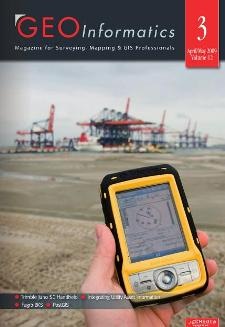Who moved my cheese?
 I really like Geoinformatics, apart from being a magazine with great taste in layout, the contents are very good in geospatial matters. Today the April version has been announced, from which I have taken some texts Highlighted in red To motivate them to the succulent reading.
I really like Geoinformatics, apart from being a magazine with great taste in layout, the contents are very good in geospatial matters. Today the April version has been announced, from which I have taken some texts Highlighted in red To motivate them to the succulent reading.
En previous versions I gave them a review, today I have taken as the subject of the post a brief but very in-depth article about the resistance towards the change that exists in making the leap towards open source technologies. It is based on that old story of the mouse that was about to die because its cheese ran out and looking for another source was against its principles; I just thought that "They had moved his cheese."
 And it is that many times those who dare to mention the words "gpl", "open source", "free", "gnu" or similar tend to be seen as aliens out of a space capsule with an eye on their forehead. We are so used to seeing the Windows logo that everything that does not run on this dinosaur seems to be complicated, the statistics show it, people prefer Internet Explorer to Mozilla, to give an example. This edition of Geoinformatics continues to talk about open technologies, in this case PostGIS And their ability to work with databases, which seems to us a good campaign as they had previously shown to GvSIG y Quantum GIS.
And it is that many times those who dare to mention the words "gpl", "open source", "free", "gnu" or similar tend to be seen as aliens out of a space capsule with an eye on their forehead. We are so used to seeing the Windows logo that everything that does not run on this dinosaur seems to be complicated, the statistics show it, people prefer Internet Explorer to Mozilla, to give an example. This edition of Geoinformatics continues to talk about open technologies, in this case PostGIS And their ability to work with databases, which seems to us a good campaign as they had previously shown to GvSIG y Quantum GIS.
In my last years I have tested using "non-conventional" programs such as manifold, Microstation, GvSIG e IntelliCAD; the results have been equal and even better, but this has caused them to see me as "complicated". I admit it, I usually am, but it is necessary to consider that in this life innovation should be sought, as long as it is not to the extreme Taken from the hair; I like Eric Van Rees's editorial when he hints "what could Google Earth be thinking, maybe under the surface".
I am aware that the world will not change from PC to Linux for many years and perhaps never, but open source technologies is a topic that is ringing in many countries with great force and unless new business models emerge that overcome major crises cyclical, time will prove us right. If not, as a football coach said, we gain experience.
 One of these days people must understand that you cannot live by pirating AutoCAD, that there is IntelliCAD there with a much lower price and even QCad at a symbolic value; of course, if you have the money and the honor, you have to buy from AutoDesk. It is also necessary to understand that 300 municipalities cannot afford an ArcGIS Server license for $ 35,000, not even all need it (or the other extensions), but that it is possible to do the same (or more) with alternatives for economic use such as Manifold, Global Mapper, gvSIG, QGis or Grass. I like a James Fee reflection that ironically says “¿Ftp access is the best you can do? "
One of these days people must understand that you cannot live by pirating AutoCAD, that there is IntelliCAD there with a much lower price and even QCad at a symbolic value; of course, if you have the money and the honor, you have to buy from AutoDesk. It is also necessary to understand that 300 municipalities cannot afford an ArcGIS Server license for $ 35,000, not even all need it (or the other extensions), but that it is possible to do the same (or more) with alternatives for economic use such as Manifold, Global Mapper, gvSIG, QGis or Grass. I like a James Fee reflection that ironically says “¿Ftp access is the best you can do? "
In the end, we may spend time and spit talking about it, it is likely, but those who try new ways of doing the same thing at a lower price gain the advantage of learning more on their own. I love the insistence of Geoinformatics in this edition, for making a cult of self-taught intuition as a necessity of man.
That these technologies are Popularize, Is in doubt.
…for now.
------------------
Oh, take a look at the magazine, which talks about:
 The Trimble Juno SC
The Trimble Juno SC - How is GIS education in schools?
- CityGML, a standard in practice
- Good practices in the implementation of GIS, a new publication of ESRI
- Integration of GIS and GRID in disaster management





